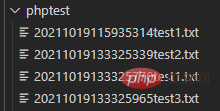
In the previous article, I brought you "How to obtain and detect file attributes in PHP? (Summary Sharing) ", which gives you a detailed introduction to the knowledge of file attributes in PHP. In this article, let's take a look at how we should upload files in PHP. I hope everyone has to help!

In our daily life, we often encounter the steps of uploading files such as uploading pictures to a circle of friends, sending attached files to emails, etc. In our PHP code , what should I do if I want to upload files? File upload is one of the very important functions in the PHP file system, so let's take a look at how to implement such a function.
Configurationphp.ini
To use the file upload function, first we need to configure php .ini, set the parameters in it appropriately. Let's first take a look at how to find the php.ini file. The example is as follows:
First we input:
<?php phpinfo(); ?>
Output result:

From the above results, in You can see the specific path of php.ini in the Loaded Configuration File column. This led to the php.ini file being found.
There are too many files in php.ini. You can use ctrl F to search for related configuration items. Then the parameters we need to configure are as follows:
file_uploads: on means that the server has enabled the file upload function; if it is off, it means that the server has turned off the file upload function. .
upload_tmp_dir: Temporary directory for uploading files. Before the file is successfully uploaded, the file will first be stored in the temporary directory on the server side. If it is not set, it will be the system default directory.
upload_max_filesize: The maximum size of files allowed to be uploaded by the server, in MB.
max_execution_time: The maximum time that a command can be executed in PHP, in seconds.
memory_limit: The memory space allocated by a command in PHP, the unit is MB.
What we need to pay attention to is: after the configuration is completed, if you want the configuration to take effect, you need to restart the Apache server for the configured parameters to take effect.
Predefined variable $_FILES
After we configure php.ini, we need to use the predefined variable $_FILES to upload The document makes some restrictions and judgments. The $_FILES variable stores information related to the uploaded file. The information that needs to be saved is as follows:
$_FILES[filename][name]: Save the uploaded file File name
$_FILES[filename][size] : Save the size of the uploaded file
$ _FILES[filename][tmp_name] : Save the temporary name of the uploaded file
##$_FILES[filename][type] : Save the type of the uploaded file
$_FILES[filename][error] : Save the code name of the uploaded file result, 0 means success
<!DOCTYPE html>
<html lang="en">
<head>
<meta charset="UTF-8">
<title>PHP文件上传</title>
</head>
<body>
<form action="" method="post" enctype="multipart/form-data">
<input type="file" name="upfile">
<input type="submit" value="上传">
</form>
</body>
</html>
<?php
if(!empty($_FILES)){
foreach ($_FILES['upfile'] as $key => $value) {
echo $key.'=>'.$value.'<br>';
}
}
?>
Single file upload
Through the above code, we have got the basic information of the file to be uploaded. Next we need to usemove_uploaded_file() Function to implement uploading. Its main function is to move the file just uploaded to a new location. Its syntax format is as follows:
move_uploaded_file(string $filename, string $destination)
$filenameb represents the file name of the uploaded file. This file name is not the original file name of the uploaded file, but is passed through $_FILES in the previous step. The file name obtained by tmp_name; $destinationb indicates the location to which the uploaded file is to be moved.
<!DOCTYPE html>
<html lang="en">
<head>
<meta charset="UTF-8">
<title>PHP文件上传</title>
</head>
<body>
<form action="" method="post" enctype="multipart/form-data">
<input type="file" name="upfile">
<input type="submit" value="上传">
</form>
</body>
</html>
<?php
if(!empty($_FILES)){
$tmpname = $_FILES['upfile']['tmp_name']; // 临时文件名称
$name = $_FILES['upfile']['name']; // 文件的原名称
$path = './phptest'; // 上传目录
$file_name = date('YmdHis').rand(100,999).$name;// 避免文件重名,更改文件名称
if(move_uploaded_file($tmpname, $path.'/'.$file_name)){
echo $name." 上传成功!";
}else{
echo $name." 上传失败!";
}
}
?>
如此则表示我想要上传的test2.txt已经上传到我需要的目录中了:

多文件上传
通过上述示例已经了解了单文件上传的过程,但是在日常使用中经常会用到的是多文件上传,那多文件上传应该怎么操作呢?
示例如下:
还和上面的示例一样,上传多个文件到我在根目录里创建的phptest文件夹里
<!DOCTYPE html>
<html lang="en">
<head>
<meta charset="UTF-8">
<title>PHP文件上传</title>
</head>
<body>
<form action="" method="post" enctype="multipart/form-data">
<input type="file" name="upfile[]"><br>
<input type="file" name="upfile[]"><br>
<input type="file" name="upfile[]"><br>
<input type="submit" value="上传">
</form>
</body>
</html>
<?php
if(!empty($_FILES)){
$tmpname = $_FILES['upfile']['tmp_name'];
$name = $_FILES['upfile']['name'];
$path = './phptest';
for ($i=0; $i < count($tmpname); $i++) {
$file_name = date('YmdHis').rand(100,999).$name[$i];
if(move_uploaded_file($tmpname[$i], $path.'/'.$file_name)){
echo $name[$i].' 上传成功!<br>';
}else{
echo $name[$i].' 上传失败!<br>';
}
}
}
?>输出结果:

如此结果显示,多个文件已经上传到我的文件夹里了:

推荐学习:《PHP视频教程》
The above is the detailed content of How to upload files in PHP? You'll understand after reading it!. For more information, please follow other related articles on the PHP Chinese website!




